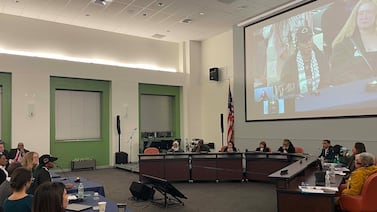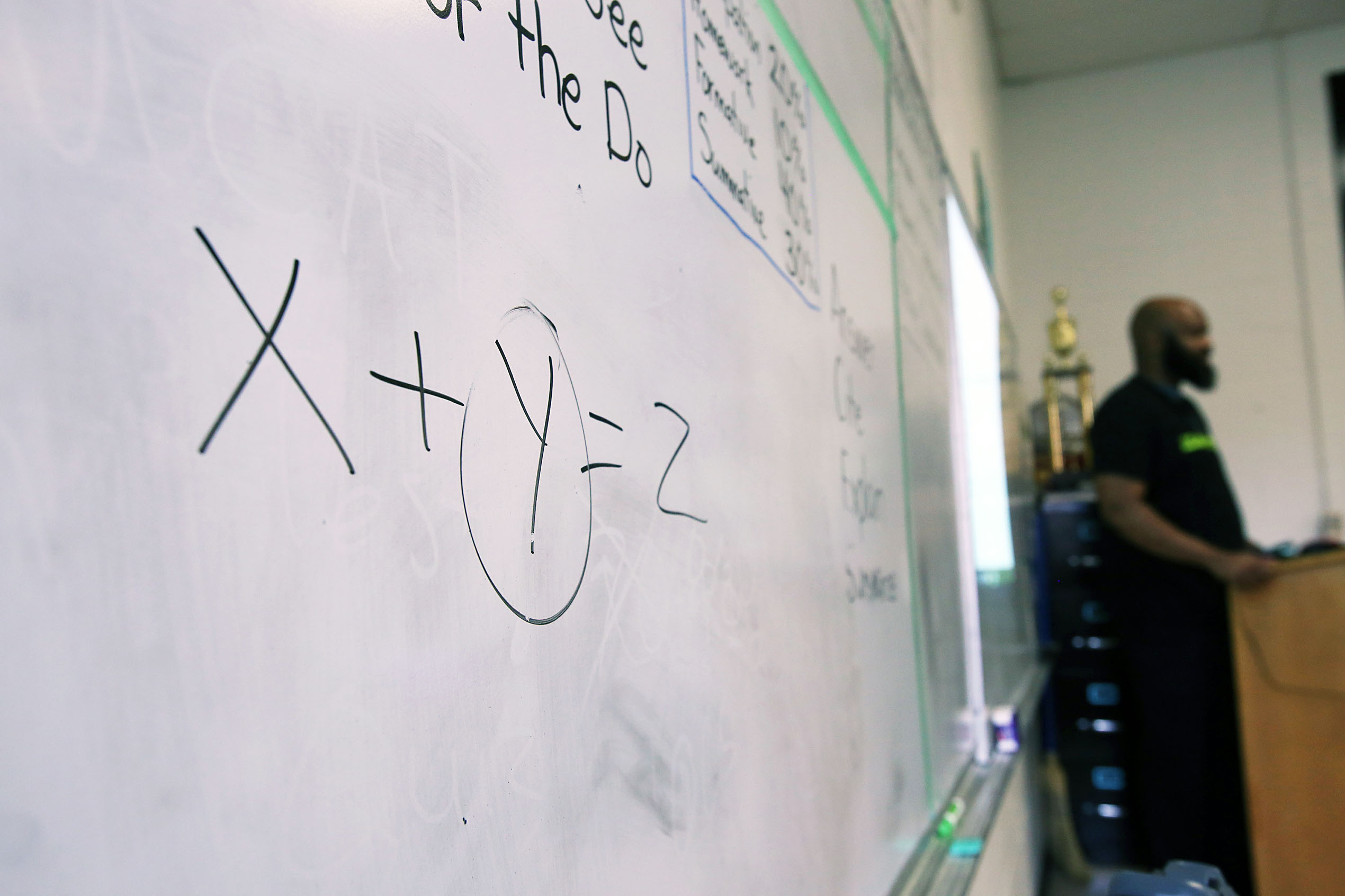Sign up for Chalkbeat Newark’s free newsletter to keep up with the city’s public school system.
For a second year in a row, Newark Public Schools’ scores on statewide assessments given in May rose by roughly 2 percentage points in English language arts and math, but remain behind pre-pandemic levels, according to a district analysis presented on Thursday.
Among Newark students in grades 3-9, 31% passed their English language arts assessment while 17.7% passed the math test, according to spring 2024 New Jersey Student Learning Assessments scores, or NJSLA, which measure student proficiency across subjects and grade levels. In spring 2023, 29% of students passed the English assessment while 15% passed the math test.
Additionally, third grade English scores remain the lowest of any grade for a third year in a row, but higher than last year’s rate of 19%.
The new scores – the third round of tests since 2019 before the emergence of COVID – highlight Newark students’ slow recovery from pandemic-era learning disruptions. In recent years, Superintendent Roger León has scaled up tutoring, summer and Saturday school efforts, and implemented new curriculums to boost academic progress among students. The district allocated an additional $6.8 million for tutoring this school year and began offering sessions on the first day of classes.
The state’s Department of Education has not yet released statewide scores.
“Parents, we need you to ensure that your child participates in tutoring this year so that we can continue to raise achievement,” said Rochanda Jackson, executive director of the Office of Policy, Planning, Evaluation, and Testing, when she presented the scores at Thursday’s school board meeting.
Students across the country are still improving academically, but not at the same pace as before the pandemic, according to the Northwest Evaluation Association. According to NWEA, students who were in grades 5 and 6 during the pandemic may need up to five years to fully recover, and even longer for those entering eighth grade or high school.
The effects of the pandemic on marginalized students, such as those from low-income families and different ethnic and racial groups, are more pronounced since those groups were among the hardest hit and remain the furthest from recovery.
In Newark, more than 90% of students identify as Black or Latino, and this year, nearly 11,000 are English language learners and roughly 7,000 are students with disabilities. In 2022, the first set of state scores since the pandemic, 27% of Newark students passed the English assessment and 13% passed the math test.
Despite slow gains, some students exceeded district expectations.
Of the district’s nearly 40,000 students, 100 received a perfect score in English, nine received a perfect score in math, and four received a perfect score in both subjects. District leaders also said they saw an increase in proficiency levels among all grade levels despite small gains.
Students show gradual improvements after district efforts
Nearly all grades experienced an increase in English language arts proficiency levels compared to spring 2023, with the most dramatic increases in grades 3, 6, and 9, according to district leaders.
But middle and high schoolers scored higher than the district’s average in English language arts last spring. Specifically, grades 6, 7, 8, and 9 are consistent with national patterns of older students performing better than their younger counterparts, Jackson added.
In spring 2024, ninth grade English proficiency scores increased by six percentage points compared to the prior year, from 32.4% to 38.1%. Sixth graders also saw a five percentage point increase this spring, from 27% to 32.2%. In third grade, a crucial year when students learn to read, scores increased by four points, from 19% to 23.4%.
Among schools, First Avenue, Ivy Hill, Lafayette, Michelle Obama, Mount Vernon, Newton, Oliver Street, Park, Ridge Street, and Wilson elementary schools had higher scores than the district’s average in English language arts, Jackson said. Among schools where ninth graders took the state test, Arts, Bard, Data Science and Information Technology, Newark Vocational, Science Park, Technology, and University high schools scored higher than the district’s average in the same subject.
District leaders are attributing the gains to the implementation of a new ELA curriculum last school year for grades K-8 to help students struggling with writing and reading issues. The district adopted a structured approach to teaching phonics by implementing SIPPS, also known as Systematic Instruction in Phonological Awareness, Phonics, and Sight Words. The district also implemented Wilson Fundations, a curriculum rooted in the science of reading that builds the foundations for reading, spelling, and handwriting.
Despite the gains in spring 2024 scores, only 23% of third graders passed the English language arts assessment, the lowest of any grade for a third year, but higher than last year’s rate of 19%. Students in grades 3, 4, and 5 were among the lowest-scoring of all grades.
Public school leaders have attributed reading issues in early grades to the switch to remote learning during the pandemic, which they say hindered students’ reading progress. The district has also said students struggle with alphabetic knowledge, or the basic ability to recognize letters and their sounds.
Overall, 3,713 students of Newark’s nearly 18,000 students who took the English language arts test moved up in proficiency levels, according to the district’s data.
The ‘lift is far greater in math’
The district’s average passing rate in math increased by 2.6 percentage points this school year and lower than in pre-pandemic years, according to Jackson.
“The lift is far greater” in math but still an increase from state test scores in spring 2022 and 2023, León said during Thursday’s school board meeting.
Districtwide, 27% of students scored proficient in the geometry assessment, a relatively small group, Jackson said, but the highest scoring of all grades. Among third graders who took the math test, 24% reached proficiency levels, the second highest scoring grade level.
Students in grades 5, 6, and 8 were among the lowest scoring of all grades, a trend inconsistent with English language arts scores. But the highest percentage of students scoring a five, or students who exceeded expectations on the test, were in grades 3, 7, 8, and those who took geometry.
Among the elementary schools, Ann Street, Roberto Clemente, First Avenue, Franklin, Ivy Hill, Lafayette, Michelle Obama, Mt. Vernon, Nelson Mandela, Sir Issac Newton, Oliver Street, Park, Ridge Street, Salome Ureña, South 17th Street, and Wilson Avenue scored higher than the district’s proficiency rate. Among the high schools, Arts, Bard, Data Science and Information Technology, Newark Vocational, Science Park, Technology, and University high schools scored higher than the district’s rate in math.
But Jackson says tutoring can help bump students to higher proficiency levels.
“If we continue to be successful in pushing those level threes to level four or five with tutoring participation this year, the math passing rate could be as high as 67%,” Jackson said.
Overall, 2,891 students of the roughly 19,500 students who took the math test moved up in proficiency levels, according to the district’s data.
Jessie Gomez is a reporter for Chalkbeat Newark, covering public education in the city. Contact Jessie at jgomez@chalkbeat.org.






